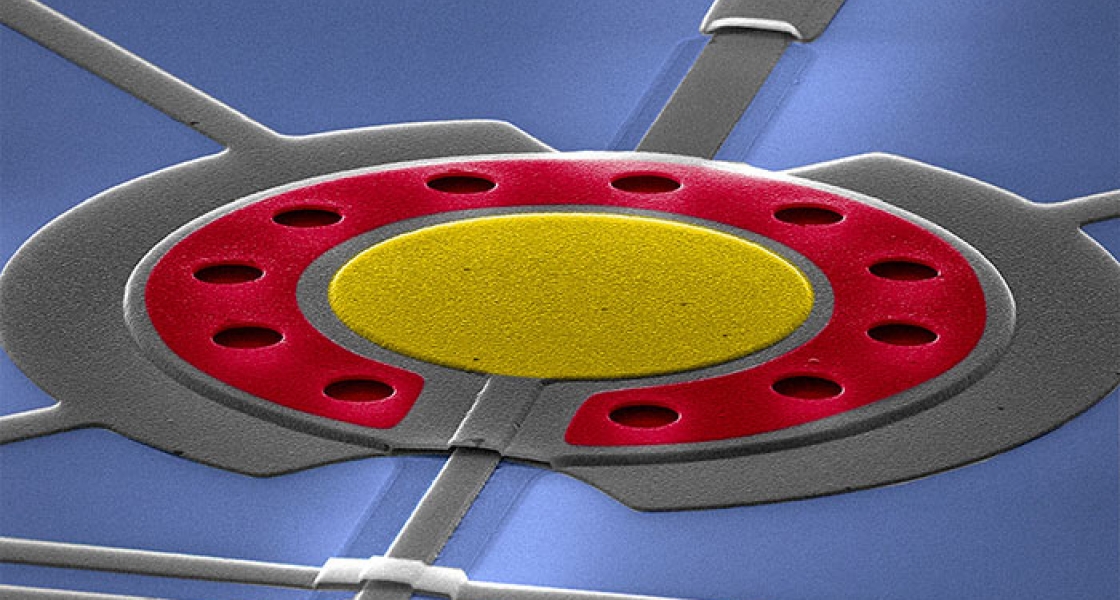Fellows Konrad Lehnert and Cindy Regal are collaborating on an ambitious undertaking to explore the quantum behavior of tiny mechanical systems that are large enough to be visible to the naked eye (as opposed to systems exhibiting quantum behavior that are no bigger than a few tens of atoms). At the same time, they have been looking for ways to prolong vibrations in mechanical objects such as drums or strings. Prolonging vibrations makes it possible to laser cool objects to temperatures where it is possible to observe quantum mechanical motion.
The Regal lab has recently completed a set of experiments that increased its understanding of the properties of tiny drums that influence the lifetime of their vibrations. The group made and characterized a series of microscopic two-layer drums of aluminum metal and silicon nitride (Si3N4) that are 100 nm thick and approximately 1 mm long. The aluminum layer was important because it represents a class of materials that offers some advantages for use in tiny drums, but which are also “bad materials” in the sense they often suppress vibrations. The studies were conducted by graduate student Pen-Li (Ben) Yu, research associate Tom Purdy, and Fellow Regal.
At first, the researchers observed that layering aluminum metal on a Si3N4 membrane made drum vibrations disappear more quickly. This effect was not unexpected. However, it opened the door to discovering exactly how the vibrations were disappearing for different vibrational patterns.
Many tiny mechanical objects vibrate like bridges, but the Si3N4 membranes studied by Yu and his colleagues pulsate more like drums. So, the researchers modeled the vibrations and their disappearance for drums. The model showed that the behavior of the vibrating drum at its very edge (only a thousandth of a millimeter wide) was responsible for most of rapid demise of the drum’s vibrations. The researchers were able to modify their two-layer drum to prove that the vibration near the very edge was the culprit. They applied aluminum metal to most of the center of a square Si3N4 drum, but left a very narrow strip around the edge uncovered.
The newly designed drum’s vibrations lasted just as long at room temperature as did those of a simple one-layer Si3N4 drum. The success of this design raises the prospect of using patterned-metal drums to circumvent the problems inherent in using bad materials. The researchers learned enough from crafting their quantum drum to help them design advanced hybrid drums for future investigations. — Julie Phillips



 The Physics Frontiers Centers (PFC) program supports university-based centers and institutes where the collective efforts of a larger group of individuals can enable transformational advances in the most promising research areas. The program is designed to foster major breakthroughs at the intellectual frontiers of physics by providing needed resources such as combinations of talents, skills, disciplines, and/or specialized infrastructure, not usually available to individual investigators or small groups, in an environment in which the collective efforts of the larger group can be shown to be seminal to promoting significant progress in the science and the education of students. PFCs also include creative, substantive activities aimed at enhancing education, broadening participation of traditionally underrepresented groups, and outreach to the scientific community and general public.
The Physics Frontiers Centers (PFC) program supports university-based centers and institutes where the collective efforts of a larger group of individuals can enable transformational advances in the most promising research areas. The program is designed to foster major breakthroughs at the intellectual frontiers of physics by providing needed resources such as combinations of talents, skills, disciplines, and/or specialized infrastructure, not usually available to individual investigators or small groups, in an environment in which the collective efforts of the larger group can be shown to be seminal to promoting significant progress in the science and the education of students. PFCs also include creative, substantive activities aimed at enhancing education, broadening participation of traditionally underrepresented groups, and outreach to the scientific community and general public.